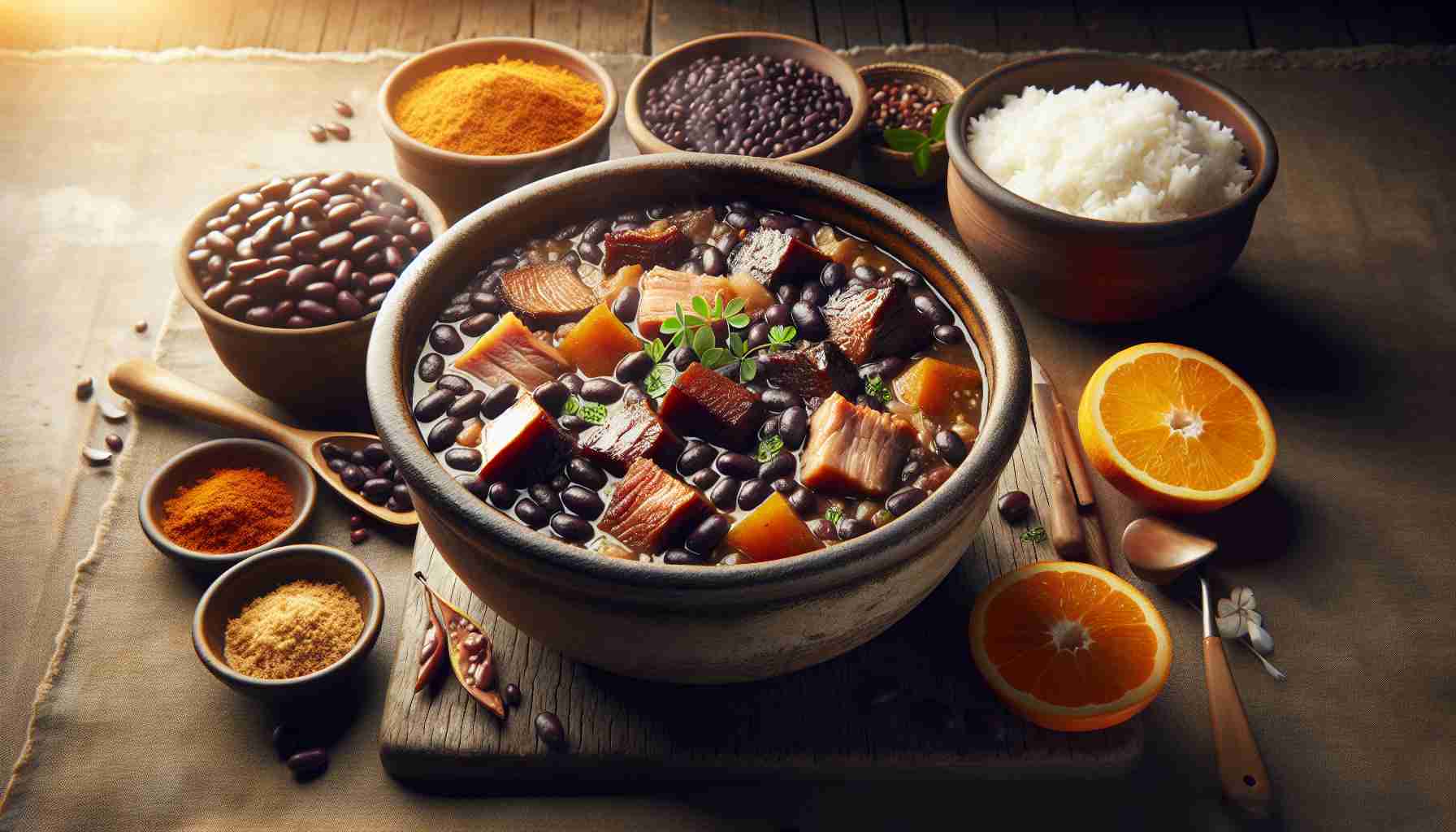In the heart of Brazil, where samba rhythms fill the air and the spirit of community thrives, there’s a dish that perfectly embodies the rich tapestry of the nation’s culture: feijoada. This hearty black bean stew, simmered with a luxurious array of smoked and fresh meats, is more than just a meal; it’s a celebration of heritage, flavors, and connections. Originating from the colonial era, feijoada was birthed in the kitchens of enslaved Africans, who ingeniously combined leftover meats with nourishing black beans. Over time, it evolved into a beloved Brazilian classic, served during festive gatherings and special occasions. The flavors of feijoada are as complex as the culture it hails from—a harmonious blend of smoky, savory, and subtly spicy notes that warm both the heart and soul. Perfect for a weekend family feast or a cozy evening with friends, feijoada is more than just a stew; it’s an invitation to experience the warmth and hospitality of Brazil.
Ingredients:
– 500g dry black beans
– 200g smoked bacon, diced
– 2 tablespoons olive oil
– 2 medium onions, diced
– 4 garlic cloves, minced
– 250g Portuguese chorizo, sliced
– 250g smoked pork ribs
– 200g pork shoulder, cut into chunks
– 2 bay leaves
– 1 teaspoon smoked paprika
– 1 teaspoon ground cumin
– Salt and freshly ground black pepper to taste
– 2 liters of water or beef broth
– 1 orange, quartered
– Fresh parsley, chopped for garnish
Instructions:
1. Prepare the Black Beans:
– Begin by rinsing the black beans under cold water. Soak them in a large bowl with plenty of water for at least 8 hours or overnight. This will help soften the beans and reduce cooking time.
2. Start the Flavor Base:
– In a large pot or Dutch oven, heat the olive oil over medium heat. Add the bacon and sauté until it becomes crispy and releases its fat. Remove the bacon with a slotted spoon and set it aside, leaving the bacon fat in the pot.
3. Sauté Aromatics:
– Add the onions to the pot and cook them until they are translucent. Stir in the garlic and cook for another minute until fragrant.
4. Brown the Meats:
– Add the chorizo, pork ribs, and pork shoulder into the pot. Cook until the meats are browned on all sides, ensuring that each piece is well-seared.
5. Combine Ingredients:
– Drain the soaked black beans and add them to the pot. Stir in the bay leaves, smoked paprika, ground cumin, salt, and pepper.
6. Simmer the Stew:
– Pour in the water or beef broth. Add the cooked bacon back into the pot. Gently place the orange quarters on top, which will add a subtle citrus aroma and flavor to the stew.
7. Cook Slowly:
– Bring the stew to a simmer, then cover and reduce the heat to low. Let it cook gently for 2 to 3 hours, or until the beans and meats are tender. Stir occasionally and add more water if needed to ensure everything is submerged.
8. Adjust and Garnish:
– Taste and adjust the seasoning with more salt and pepper if necessary. Before serving, remove the orange quarters and bay leaves. Garnish with freshly chopped parsley.
Cooking Tips:
– To add more depth of flavor, consider adding a smoked ham hock or trotter into the stew during cooking.
– For a spicier kick, include some chopped chili peppers or a pinch of cayenne pepper.
Serving Suggestions:
– Serve feijoada hot with traditional accompaniments like white rice, sautéed collard greens, and orange slices.
– Pair with a refreshing Caipirinha cocktail to enhance the dining experience.
Feijoada is more than just a dish; it’s a journey into the heart of Brazilian culinary tradition. Gather your loved ones, savor each spoonful, and let the flavors transport you to a place where food is not just sustenance, but a celebration of life and culture.
The Surprising Controversies Behind Brazil’s Iconic Feijoada
Feijoada, a centerpiece of Brazilian gastronomy, is not only a dish but a culinary mosaic of history and culture, bringing people together over its hearty mix of black beans and meats. However, beneath its revered status lie fascinating anecdotes and controversies.
While feijoada is often linked to the legacy of enslaved Africans in Brazil, historians debate its precise origins. Could it be that feijoada has a more complex history tied to Portuguese and Indigenous culinary traditions as well? Some suggest that similar dishes existed in Portugal long before and that the inclusion of native Brazilian ingredients enriched its current form.
Another polarizing aspect involves the ideal way to prepare and enjoy feijoada. The authenticity debate often centers around which meats and spices truly belong in the pot. Should one stick with traditional pork cuts, or is it acceptable to introduce modern variants? The role of a little-known ingredient—often skipped but traditionally used—is dried beef, or “carne seca,” which is frequently discussed among purists.
Questions also arise about the cultural significance of serving feijoada on specific days. In Brazil, Saturday is the unofficial feijoada day, yet many speculate this tradition’s origins are more utilitarian than cultural, as it allows for a lengthy cooking process that was feasible on weekends in working-class households TripAdvisor.
Moreover, feijoada’s health implications stir debates too. While nutritious, its rich and meaty composition poses cholesterol-related concerns, challenging health-conscious diners who adore the dish.
Ultimately, these nuances make feijoada more than a meal; it is a subject of rich dialogue and community ties. So next time you savor this iconic stew, ponder its textured history and the lively discourse it inspires.












